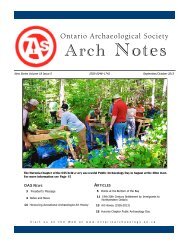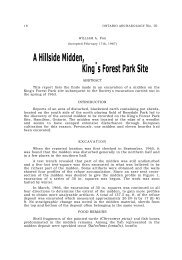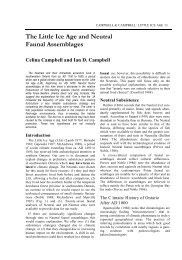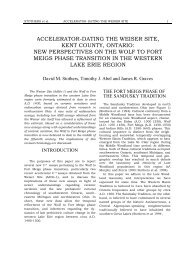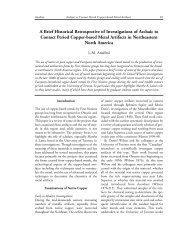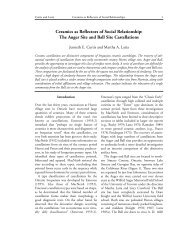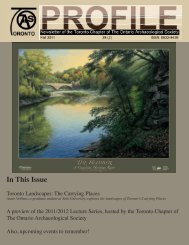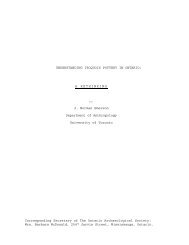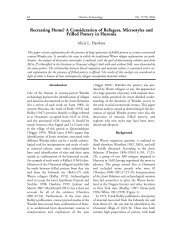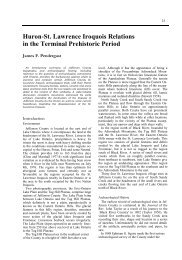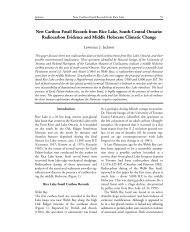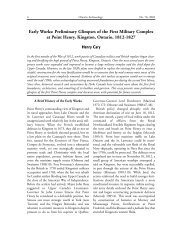oa 81 part 02 - Ontario Archaeological Society
oa 81 part 02 - Ontario Archaeological Society
oa 81 part 02 - Ontario Archaeological Society
You also want an ePaper? Increase the reach of your titles
YUMPU automatically turns print PDFs into web optimized ePapers that Google loves.
4 <strong>Ontario</strong> Archaeology No. <strong>81</strong>/82, 2006Figure 1. Area in Renfrew County visited by Champlain, June 1613 showing the r<strong>oa</strong>d grid and other modern features, as depictedon 1:250,000 scale map sheet, and the location of the Muskrat Lake geological fault. Only features mentioned in text are labeled. Basemap information: Natural Resources Canada (2001).
6 <strong>Ontario</strong> Archaeology No. <strong>81</strong>/82, 2006which is mentioned in a footnote supportingChamplain’s observations (Biggar 1922-1936:2:279-280).Mrs. Carl Price and Clyde C. Kennedy notedthree periods of occupation on this island:The latest Indian people to camp there,who could well be the Algonquin met byChamplain, left pieces of pottery, stonetools and weapons, and glass trade beads.Also found at the site were pieces of brasstrade pots and iron awls. [Price andKennedy 1961:23]Champlain’s Land LeagueSamuel de Champlain had a good compass set tothe magnetic meridian and was very precise in itsuse and well prepared to correct his readings totrue north (Heidenreich 1976:55). FromChamplain’s records, Heidenreich correctly identifiedhis land routes, which the explorer measuredin leagues. Heidenreich states that the JesuitFathers used the lieue d’une heure, about threestatute miles (Heidenreich 1968:40), and commentson other leagues in use at the time andunder which situations certain leagues were used.Champlain used a league that averaged 2.1 miles,or 3.4 km, during travel on inland routes(Heidenreich 1976:44-46). James Pendergastscaled a modern map over the 89-league routeChamplain had traveled to the Kichesipirini onMorrison Island from near the Sault St. Louisand found that Champlain was using a leagueapproximately equivalent to 2.3 to 2.4 statutemiles (3.7 to 3.8 km) (Pendergast 1999:85).Champlain’s Muskrat Lake RouteChamplain clearly declared they had canoednearly seven leagues down Lac de Nibachis, thenwalked northeast one league over a pleasant landscapewith well-beaten trails and found ChiefTessoüat’s camp on a lake. The most commonand convincing route known by historians indicatedthat Champlain was escorted, by canoe, tothe northern end of modern Muskrat Lake. Fromthere the group portaged over Stoqua’s PortageR<strong>oa</strong>d to Lower Allumette Lake near Perretton(Figures 1, 3 and 4). Supposition of this routewas probably based on a map by J. L. Morris,which puts the end of Stoqua’s Portage R<strong>oa</strong>d andTessoüat’s encampment near Perretton on LowerAllumette Lake (Figure 3; Biggar 1922-1936:2:Plate 11).Notes on the History of Renfrew County onlymentions that “The <strong>part</strong>y paddled alongMuskrat Lake to its northerly end, then portagedacross to the widening of the Ottawa River nowknown as Lower Allumette Lake. ThereChamplain met Tessoüat” (Price and Kennedy1961:21). Clyde C. Kennedy indicated on hismap that Champlain traversed the same generalland route from the north end of Muskrat Laketo Morrison Island as shown on the map byMorris (Kennedy 1970:72).Stoqua’s Portage R<strong>oa</strong>dStarting from the north end of Muskrat Lake,Stoqua’s Portage R<strong>oa</strong>d to Perretton extendsapproximately northeast (Figures 3 and 4). Thelanding is about 15 km from the head of themarsh at the south end of Muskrat Lake. Ther<strong>oa</strong>d measures about 4.8 km in length, one lieued’une heure, from the landing to Lower AllumetteLake at Perretton (Figure 1). This portage is alsoshown on J. McNaughton’s map of 1832-1836and could be the portage described byChamplain. Historians concluded in the earlytwentieth century that Stoqua’s Portage R<strong>oa</strong>d,4.8 km in length, would be an acceptable choiceto satisfy Champlain’s records (Figure 3).The Indian R<strong>oa</strong>dIndian R<strong>oa</strong>d leads over the bedrock fault that wasthe genesis of Muskrat Lake and the MuskratRiver channel (Figures 1 and 4). The originalcondition of this portage cannot be determined,as the r<strong>oa</strong>dway has been graded for modern traffic.The steep fault runs past Cobden, throughMuskrat Lake, and continues northwest fourkilometres south of Pembroke.Modern Indian R<strong>oa</strong>d begins at the base of thefault where Highway 417 crosses the Muskrat
Croft Champlain’s Portage from Muskrat Lake to the Ottawa River 7Figure 3. J.L. Morris’ map of Champlain’s route from near Gould’s Wharf on the Ottawa River to Muskrat Lake, Stoqua’sPortage and Lower Allumette Lake (Biggar 1922-1936:2:Plate 11).
8 <strong>Ontario</strong> Archaeology No. <strong>81</strong>/82, 2006Figure 4. Part of Westmeath Township, Renfrew County, showing the locations of the Winter R<strong>oa</strong>d (coinciding with the proposedMeath Portage) and Stoqua’s Portage R<strong>oa</strong>d, from McNaughton’s map of 1832 (Archives of <strong>Ontario</strong> 1836), when bothr<strong>oa</strong>ds existed between Mud Lake and Lower Allumette Lakes. Base map information: Natural Resources Canada (2001).River. A branch r<strong>oa</strong>d leading north to Greenwoodand Pembroke from the top of the fault representsa wagon r<strong>oa</strong>d. Indian R<strong>oa</strong>d continues as a straightrural r<strong>oa</strong>d northeast to Perretton, in agreementwith Samuel de Champlain’s compass bearing. Italso represents the north border of Lot 20, concessionsA and B, of Westmeath Township. Thisstraight rural r<strong>oa</strong>d is not typical of a portage. It has,however, been an historic connection between theMuskrat River and Lower Allumette Lake. Theportage entrance at Indian R<strong>oa</strong>d is downriver fromStoqua’s Portage R<strong>oa</strong>d, and 17 km from the headof the marsh at modern Muskrat Lake. Theentrance gradient is steep, rising from the MuskratRiver at 124 m (amsl) to about 150 m (amsl).The Indian R<strong>oa</strong>d location has remained an historicmeeting point of transportation systems sincethe steamb<strong>oa</strong>t era of 1851. Freight transfer duringperiods of low water may have been the primaryand historic purpose of this steep route. The IndianR<strong>oa</strong>d portage would be an efficient transfer pointfor freight coming down Muskrat Lake by steamb<strong>oa</strong>tfrom Cobden. During periods of very lowwater, it was necessary for steamb<strong>oa</strong>ts to unl<strong>oa</strong>d at
10 <strong>Ontario</strong> Archaeology No. <strong>81</strong>/82, 2006Muskrat Lake to the Meath Portage entrance atMeath Lake by canoe is about 22 km whenscaled on topographical maps. This distanceincludes the swampy areas at the head of theselakes, and the assumed circuitous canoe tripthrough Mud Lake into Meath Lake. A distanceof 22 km is in close agreement with a distance ofnearly seven leagues recorded by Champlain forthe length of Lac de Nibachis (Biggar 1922-1936:2:277) when using the petite lieue averageof 3.4 km (2.1 statute miles) (Heidenreich1976:44-46), rather than the 4.8 km (3 statutemiles) used previously by researchers.The Meath Portage extends about 3.8 km fromMeath Lake to Lower Allumette Lake. If higherwater levels than present occurred in LowerAllumette Lake, as seems likely, the portagewould have been shorter, consistent with a totallength of 3.4 km, or one petite lieue, the distancerecorded by Champlain for the overland trailfrom Lac de Nibachis to Tessoüat’s encampment.The Meath PortageThe Canadian Central Railr<strong>oa</strong>d was built in 1876between steep hills rising to 145 m (amsl) at theentrance at Meath Lake (Figure 4). Preparatoryconstruction work would have been necessary tomake this route suitable for this railway thatinclines from about 123 m (amsl) at Meath Lake t<strong>oa</strong>bout 137 m (amsl), before declination towardLower Allumette Lake. A portage trail possibly ledthrough this route to the north before railr<strong>oa</strong>d construction.Other walking routes could also, however,have been chosen. Champlain stated that thetrail to Lower Allumette Lake was to the northeast,not the route later taken by the railway. Tessoüat’scamp was probably located on the involuted southshore of Lower Allumette Lake, east of the presentdaylocation of Greenwood (Figure 1).Stoqua’s Portage versus the Meath PortageStoqua’s Portage and the Meath Portage are bothcontenders as walking routes (Figure 4). Thereare, however, some important differencesbetween them when each is considered from thepoint of view of Champlain’s guides in 1613.Stoqua’s Portage R<strong>oa</strong>d would be convenientwhen canoeing from the head of Muskrat Lakeand portaging to Lower Allumette Lake. Near thelocation of present-day Perretton, however, itcrosses the same stream twice. It is also longer thanthe Meath Portage. Low, wet areas of Stoqua’sPortage R<strong>oa</strong>d may have been sufficient reason forChamplain’s guides to avoid this route in favour ofthe Meath route, which was accessible by canoethrough the surrounding wetland. Considerationof the destination may have been more importantthan the condition of the trail. The Meathroute may have been deemed more suitable thanStoqua’s Portage R<strong>oa</strong>d for an important visitor.The Meath Portage would have been convenient,enabling a short overland trip to an importantdestination well known to Champlain’s guides.Tessoüat’s abode on Morrison Island would fitsuch an important destination, located near theend of a 3.8-km route to the northeast.The Winter R<strong>oa</strong>d used by early settlers waslikely based on a portage route from LowerAllumette Lake to the Muskrat Lake wetlandestablished sometime during the precontact era.This trail led directly to locations on the OttawaRiver near Morrison Island, where both MiddleArchaic period materials (5000-4000 B.P.) aswell as contact period artifacts dating to the timeof Champlain have been found (Clermont andChapdelaine 1998). The Meath Portage couldhave been used for several thousand years, providingan efficient means of travel to exploit theexcellent fishing in Lac de Nibachis. The 783-haMuskrat River wetland is an important waterfowlbreeding area where 17 species of cold andwarm water fish have been recorded (<strong>Ontario</strong>Ministry of Natural Resources 1990:31). Samuelde Champlain stated that this lake is so “abundantin fish that all the local surrounding tribesdo their fishing here” (Biggar 1922-1936:2:275).ConclusionsAccepting the Meath Portage as the route fromthe head of Muskrat Lake to Lower AllumetteLake taken by Samuel de Champlain in 1613,and published in 1614, meets our expectations ofhis known cartographic ability. Distances equatewell with the petite lieue as the league used by
Croft Champlain’s Portage from Muskrat Lake to the Ottawa River 11Champlain and support his description of hisvisit to Muskrat Lake and Lower Allumette Lake.On the seventh day of June 1613, Champlain’sAlgonquin guides paddled down the length ofmodern Muskrat Lake and into the MuskratRiver wetland. Because of spring flooding,Champlain considered Muskrat, Mud andMeath Lakes, including the adjacent wetland, tobe one lake. From Mud Lake they entered MeathLake, where they landed and walked over an easyportage route for a distance of 3.8 km, about onepetite lieue, northeast to Lower Allumette Lakenear Morrison Island.Champlain estimated that Lac de Nibachis wasseven leagues long, as it extended at the time oneleague beyond the Meath Portage. He estimatedthat this lake was two leagues wide, a perceptionwhich is reasonable considering the large size of theflooded wetland he witnessed. The Meath Portageentrance at Meath Lake is situated about 22 km,six petite lieue, by canoe, from the head of modernMuskrat Lake. The Meath route leads from MeathLake one petite lieue to the northeast to LowerAllumette Lake. This was Samuel de Champlain’sdestination as determined by historians.A coincidental match between lieue d’uneheure, 4.8 km, and the length of Stoqua’s PortageR<strong>oa</strong>d seemed to indicate to historians in thetwentieth century a reasonable choice of route.They were unaware of the average 3.4-km, oneleagueequivalent that Samuel de Champlain wasusing on overland expeditions and were thus baffledby his perception of the length and breadthof Muskrat Lake. Stoqua’s Portage R<strong>oa</strong>d, ratherthan the Meath route, came to be accepted,incorrectly, as being Champlain’s portage routeto Lower Allumette Lake.Acknowledgments. I wish to acknowledge H.P.Biggar (The Works of Samuel de Champlain [1922-1936]) and other historians who, together, haverecorded almost 400 years of history in the OttawaValley; from 1613 to the twenty-first century. Ithank Mr. and Mrs. John McLaren and family fortheir hospitality and friendship and also for suggestinglocal topographical information. Dr.Donald S. Robertson provided his canoe and withthe author investigated the Muskrat River and wetland.My thanks to Ken Swayze for his study concerningthe locations of Algonquin villages in hispaper on Logos Land and his encouragement topursue archaeological investigation of Champlain’sroute. My thanks also to Ian Badgley for his help insecuring reference material. Typing and mappingwere supported by Mary M. Croft. Maps and articleson the local forest fires were supplied by JackiePatterson and May Prange of the Upper OttawaGenealogy Group and the Champlain Trail andPioneer Village Museum, Pembroke, <strong>Ontario</strong>.Terry McLeish, Ministry of Natural Resources,Pembroke, and David T. Croft provided access toWestmeath Township maps. Angela Woollam generouslysuggested structural changes and reviewedCanadian grammar. My appreciation to Dr. Jean-Luc Pilon, <strong>Archaeological</strong> Survey of Canada, forgenerously editing early drafts of this paper and hissuggested additions, changes, and clarification.Andrew Stewart edited later drafts and assembledFigures 1 and 4 from digital spatial data availablefrom the National Topographic Database.References CitedArchives of <strong>Ontario</strong>1836 Township Plan, Westmeath Township.[map, J. McNaughton, surveyor] C. 277-1-431-0-1. Archives of <strong>Ontario</strong>, Toronto.Biggar, H.P. (editor)1922-1936 The Works of Samuel de Champlain. 6 vols.Champlain <strong>Society</strong>, Toronto.Clermont, N., and C. Chapdelaine1998 Ile Morrison Lieu sacré et atelier del’Archaïque dans L’Outaouais. Paléo-Québec28. Recherches amérindiennes au Québec,Montréal.Heidenreich, C.E.1968 A New Location for Carhagouha, RecollectMission in Huronia, <strong>Ontario</strong>. <strong>Ontario</strong>Archaeology 11:39-46.1976 Explorations and Mapping of Samuel deChamplain 1603-1632. Canadian Cartographer13(2):1-140.Kennedy, C.C.1970 The Upper Ottawa Valley. Renfrew CountyCouncil, Pembroke, <strong>Ontario</strong>.
12 <strong>Ontario</strong> Archaeology No. <strong>81</strong>/82, 2006Natural Resources Canada2001 031F [map sheet] Vector Digital Data.National Topographic Data Base edition 3.3.Scale 1:250,000. Centre for TopographicInformation, Sherbrooke. http://geogratis.gc.ca<strong>Ontario</strong> Ministry of Natural Resources, PembrokeDistrict1990 Review and Recommendations for theCounty Dam on the Muskrat River:Muskrat River Profile. Ms. on file, <strong>Ontario</strong>Ministry Of Natural Resources, PembrokeDistrict, Pembroke, <strong>Ontario</strong>.Pendergast, J.F.1999 The Ottawa River Algonquin Bands in a St.Lawrence Iroquoian Context. CanadianJournal of Archaeology 23:63-136.Perth Courier1856 Disastrous Fire, Several Families Houseless.Perth Courier, page 3. June 6, 1856.Price, C.1957 Centennial: 100 th Anniversary of the NorthRenfrew Agricultural <strong>Society</strong>. Donald F.Runge, Pembroke, <strong>Ontario</strong>.Price C., and C.C. Kennedy,1961 Notes on the History of Renfrew County:Centennial 1961. Renfrew County Council,Pembroke, <strong>Ontario</strong>Swayze, K.,2001 <strong>Archaeological</strong> Investigations at Logos LandResort, Whitewater Region, Renfrew County.Ms on file, <strong>Ontario</strong> Ministry of Culture,Toronto.Une étude de cartes topographiques et de photos aériennes supporte la précision des camps et desportages enregistrés par Champlain lors de son court séjour dans la vallée de l’Outaouais. En 1613,Champlain débuta son voyage près de la communauté actuelle de Cobden sur le lac Muskrat pour serendre au lac aux Allumettes, un élargissement de la rivière des Outaouais près de la ville actuelle dePembroke. La précision des distances et des routes documentées par Champlain a été questionnée pardes historiens du XXe siècle. Cette étude réfute les conclusions erronées qui ont été publié par ceshistoriens confus par les records métriques et géographiques de Champlain.David J.A. Croft115 Cockburn CrescentPembroke <strong>Ontario</strong> K8A 8L9dmk.croft@sympatico.ca




